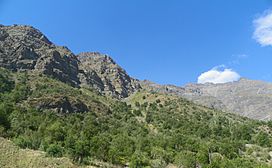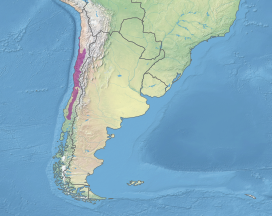Chilean Matorral facts for kids
Quick facts for kids Chilean Matorral (NT1201) |
|
|---|---|

Matorral scene in San José de Maipo
|
|

Location in Chile
|
|
| Ecology | |
| Realm | Neotropical |
| Biome | Mediterranean forests, woodlands, and scrub |
| Borders | Atacama Desert, Central Andean dry puna, Southern Andean steppe, and Valdivian temperate forests |
| Geography | |
| Area | 148,500 km2 (57,300 sq mi) |
| Country | Chile |
| Climate type | BSk: arid, steppe, cold arid |
| Conservation | |
| Protected | 2,947 km² (2%) |
The Chilean Matorral (NT1201) is a special natural area in central Chile. It's located on the western coast of South America. This region is known as a "terrestrial ecoregion," which means it's a large area of land with its own unique plants and animals.
The Chilean Matorral has a Mediterranean climate. This means it has rainy winters and dry, warm summers. It sits between the very dry Atacama Desert to the north and the wetter Valdivian temperate forests to the south. This ecoregion is home to many different types of plant life. You can find tall shrublands (called matorral), forests, woodlands, savannas, and even low scrublands here.
The Chilean Matorral is one of only five places in the world with a Mediterranean climate. These special regions are always found in the middle parts of continents, on their western coasts. The other Mediterranean climate areas include the Mediterranean Basin (around the Mediterranean Sea), the California chaparral and woodlands in North America, the Cape Province in South Africa, and Southwest Australia.
Contents
Where is the Chilean Matorral?
The Matorral region is in central Chile. It stretches from about 32° to 37° south latitude. To the west, you'll find the Pacific Ocean. The Chilean Coastal Range runs along the coast.
Between the Coastal Range and the Andes Mountains is the Chilean Central Valley. The Andes Mountains form the eastern border of the Matorral. To the north, the extremely dry Atacama desert begins. This desert separates the Matorral from the tropical forests found further north in South America.
A semi-desert area called El Norte Chico (the "little north") is a transition zone. It lies between 28° and 32° south latitude, connecting the Atacama desert to the Matorral. To the south, the climate becomes cooler and wetter. This is where the Valdivian temperate forests ecoregion begins. These forests include special types like the Maulino forest and many of South America's temperate rain forests.
Amazing Plants of the Matorral
The Chilean Matorral ecoregion has many different plant communities. In the northern parts, where it transitions to the dry Atacama, you'll find semi-desert scrub. Further south, you can see matorral, woodlands, forests, and savannas.
- Coastal Semi-Desert Scrub: This plant community is also called lomas. It forms a narrow strip along the Pacific coast. It stretches from 32° to 24° South latitude, from sea level up to about 1,200 meters high on the Chilean Coast Range. Fog and low clouds from the sea bring moisture. This helps keep summer temperatures cooler than inland. Plants here include shrubs up to 2 meters tall and tall cactus plants (3–4 meters). Where the fog is thickest, up to 80% of the ground is covered by plants.
- Coastal Matorral: This is a low, soft scrubland found along the coast. It goes from La Serena in the north to Valparaiso in the south. In less dry areas, it's a shrubland with plants 1.5 to 2 meters tall. You'll also see succulent plants and tall cacti. Some common plants are the palhuén (Adesmia microphylla) and the wild coastal fuchsia (Fuchsia lycioides). This coastal matorral is similar to the garrigue in the Mediterranean Basin.
- Matorral: This is a type of shrubland with "hard-leaved" shrubs and small trees. It also has cactus and bromeliads. Common plants include litre (Lithraea caustica), quillay ((Quillaja saponaria)), and bromeliads from the Puya group. There are also many herbs, vines, and plants with underground bulbs. The matorral is like the chaparral found in California.
- Espinal: This is a savanna plant community. It has widely spaced groups of trees, mainly Espino ((Vachellia caven)) and spiny carob trees ((Prosopis chilensis)). The ground beneath them is covered with grasses that came from the Mediterranean Basin in the 1500s. Much of the espinal used to be matorral. It changed over time because of heavy grazing by sheep, goats, and cattle.
- Sclerophyll Woodlands and Forests: These forests used to cover much more land. Now, they exist in small patches in the coastal ranges and near the Andes mountains. They are mostly made up of evergreen trees with hard leaves. Examples include peumo ((Cryptocarya alba)), boldo (Peumus boldus), and the Chilean wine palm (Jubaea chilensis).
The Chilean Matorral has many plant species found nowhere else in the world. About 95% of its plant species are unique to Chile. These include Gomortega keule, Pitavia punctata, Nothofagus alessandrii, and the famous Chilean wine palm.
Amazing Animals of the Matorral
The Chilean Matorral is home to many different animals. Scientists estimate there are about 200 native bird species, 37 mammals, 38 reptiles, and 12 amphibians. Many of these animals are found only in this region. For example, there are 7 bird species, 7 mammal species, 31 reptile species, and 6 amphibian species that are unique to the Matorral.
Birds of the Matorral
Some birds that live only or mostly in this area include the Chilean tinamou (Nothoprocta perdicaria), the moustached turca (Pteroptochos megapodius), and the Chilean mockingbird (Mimus thenca). This ecoregion is considered a special "Endemic Bird Area" for central Chile.
Mammals of the Matorral
Native mammals here include the common degu (Octodon degus), a small rodent, and the pichi or dwarf armadillo (Zaedyus pichiy). You might also find the southern river otter (Lontra provocax). The guanaco (Lama guanacoe), a type of llama, used to live here but is now gone from this ecoregion.
Predators in the Matorral include the puma (Puma concolor), the Andean mountain cat (Leopardus jacobita), and the culpeo or Andean wolf (Pseudalopex culpaeus).
Reptiles of the Matorral
Many reptiles are unique to this area. Several types of tree iguanas live here, such as the black-spotted tree iguana (Liolaemus nigromaculatus) and the Chilean tree iguana (Liolaemus chiliensis). Other unique reptiles include Alvaro's anole (Pristidactylus alvaroi) and the spotted false monitor (Callopistes maculatus).
Amphibians of the Matorral
Native amphibians include the Atacama toad (Rhinella atacamensis) in the northern part of the region. You can also find the banded wood frog (Batrachyla taeniata) and the Chile four-eyed frog (Pleurodema thaul).
Protecting the Matorral
The Matorral ecoregion is where most of Chile's people live. It's also home to the country's largest cities. The Central Valley is Chile's main farming area. Because of this, the region faces many threats. These include farming, heavy grazing by animals, logging, and the growth of cities.
Grasses and other plants brought from the Mediterranean Basin have spread widely. They are taking over areas where native plants used to grow. Much of the original forest and woodland has been damaged. It has turned into matorral or scrub, and much of the matorral has become sparse scrub. Other dangers include human-caused fires and too much grazing by introduced rabbits, hares, and goats.
Sadly, the Matorral is the least protected of Chile's ecoregions. Only about 1.3% of the area is protected by national parks and reserves. Some of the protected areas include:
- Lago Peñuelas National Reserve
- Río Blanco National Reserve
- Bosque de Fray Jorge National Park
- Las Palmas de Cocalán National Park
- Llanos de Challe National Park
- Pan de Azúcar National Park
- Morro Moreno National Park
- Las Chinchillas National Reserve
- Pingüino de Humboldt National Reserve
- El Yali National Reserve
- Roblería del Cobre de Loncha National Reserve
Images for kids
See also
 In Spanish: Ecorregión del matorral chileno para niños
In Spanish: Ecorregión del matorral chileno para niños



